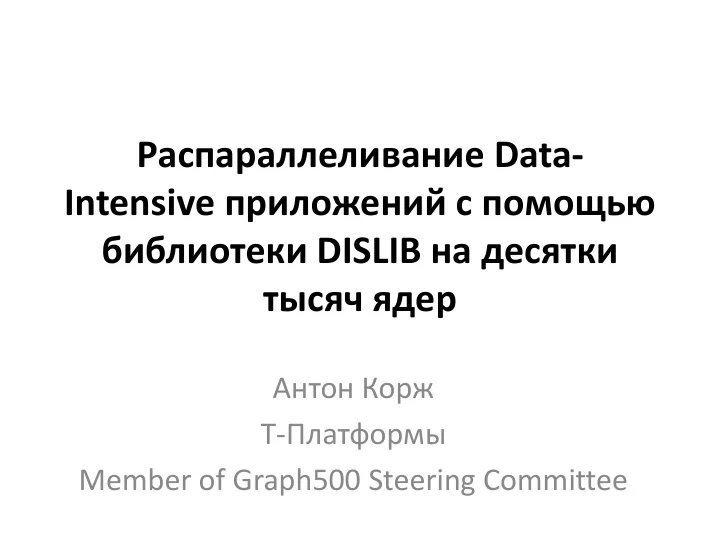

Распараллеливание Data- Intensive приложений с помощью библиотеки DISLIB на десятки тысяч ядер Антон Корж Т - Платформы Member of Graph500 Steering Committee
What is the Graph500? • New benchmark to complement the Top 500 for large-scale data analysis problems • International Multidisciplinary Steering Committee – Jim Ang, David A. Bader, Brian Barrett, Jon Berry, Bill Brantley, Almadena Chtchelkanova, John Daly, John Feo, Michael Garland, John Gilbert, Bill Gropp, Bill Harrod, Bruce Hendrickson, Anton Korzh, Jure Leskovec, Bob Lucas, Andrew Lumsdaine, Mike Merrill, Hans Meuer, David Mizell, Shoaib Mufti, Richard Murphy, Nick Nystrom, Fabrizio Petrini, Wilf Pinfold, Steve Poole, Arun Rodrigues, Rob Schreiber, John Simmons, Marc Snir, Thomas Sterling, Blair Sullivan, T.C. Tuan, Jeff Vetter, Mike Vildibill • Three Kernels – Search (Concurrent Search, the Ranking Kernel) – Optimization (Single Source Shortest Path, almost released) – Edge Oriented (Maximal Independent Set, in specification)
History of the Graph500 • Graph500 announced at ISC10 (June 2010) • 1 st Graph500 List: 9 machines at SC10 (Nov. 2010) • 2 nd Graph500 List: 29 machines at ISC11 (June 2011) • 3 rd Graph500 List: 51 machines at SC11 (Nov. 2011) • 4 th Graph500 List: 88 entries at ISC 12 (June 2012) • 5 th Graph500 List: 124 entries at SC12 (Nov. 2012) • 6 th Graph500 List: 142 entries at ISC13 (June 2013) • 7 th Graph500 List: 160 entries at SC13 (Nov. 2013) [TODAY!]
Five Business Areas • Cybersecurity – 15 Billion Log Entires/Day (for large enterprises) • Data Enrichment – Full Data Scan with End-to-End Join – Easily PB of data Required – Example: Maritime Domain • Medical Informatics Awareness – 50M patient records, 20-200 • Hundreds of Millions of records/patient, billions of individuals Transponders – Entity Resolution Important • Tens of Thousands of Cargo Ships • • Tens of Millions of Pieces of Bulk Social Networks Cargo – Example, Facebook, Twitter • May involve additional data – Nearly Unbounded Dataset Size (images, etc.) • Symbolic Networks – Example, the Human Brain – 25B Neurons – 7,000+ Connections/Neuron
www.GRAPH500.org
7 th Graph 500 List (followed by special highlights) # of Entries 160 142 124 88 9 28 51 1st 2nd 3rd 4th 5th 6th 7th
7 th Graph 500 List Country # entries % entries Amsterdam 2 1.3% Australia 1 0.6% Canada 3 1.9% China 6 3.8% France 2 1.3% Germany 3 1.9% Italy 2 1.3% Japan 39 24.4% Luxembourg 1 0.6% Poland 1 0.6% Russia 6 3.8% Russian Federation 1 0.6% South Korea 1 0.6% Switzerland 6 3.8% Taiwan 6 3.8% UK 4 2.5% USA 76 47.5% Grand Total 160
7 th Graph 500: Trends -- TEPS Slide credit: Scott Beamer
7 th Graph 500: Trends -- Cores Slide credit: Scott Beamer
Performance (Edges/Second), (TEPS) 7 th Graph500 List Graph Size vs. Performance Slide credit: Jason Riedy Normalized Graph Data Structure Size
Highlights of the 7 th Graph500 List • The list is growing! • Top systems have leveled off • Three vendors account for approximately half the list. • Graph500 and Top500 rankings are not strongly correlated! • Top500’s #1 system (Tianhe -2) is ranked #6 on Graph500 • Graph500’s #1 system (Sequoia) is ranked #3 on Top500
DISLIB • Расширение SHMEM активными сообщениями • Вместо shmem_put shmem_send • Прозрачная агрегация сообщений • Эффективная реализация для кластеров с малореактивным интерконнектом • Поддержка многоядерности
DISLIB History of Success • 2009 NPB UA, dcmf version (BlueGene/P) • 2010 GASNET-version (IB) • 2011 Graph500 (BFS) • 2011 MPI version +multicore optimized • 2013 Quantum Computer • 2014 Students, SSSP
#include "dislib.h ” int *data; void allgather_hndl(int from, void* message, int size) { data[from] = * (int*)message; } void main(int argc, char** argv) { shmem_init(&argc,&argv); shmem_register_handler(allgather_hndl,1); data=malloc( sizeof(int) * num_pes() ); data[my_pe()] = 57*my_pe(); shmem_barrier_all(); for(int i=0;i<num_pes();i++) shmem_send (data+my_pe(),1,sizeof(int),i); shmem_barrier_all(); shmem_finalize(); }
if (VERTEX_OWNER(root) == my_pe()) { SET_VISITED(root); BFS q1[0]=VERTEX_LOCAL(root); qc=1; } shmem_register_handler(visithndl,1); shmem_barrier_all(); sum=1; while(sum!=0) { for(i=0;i<qc;i++) for(j=g->rowsIndices[q1[i]];j<g->rowsIndices[q1[i]+1];j++) send_vertex(g->endV[j]); shmem_barrier_all(); qc=q2c;q2c=0;int *tmp=q1;q1=q2;q2=tmp; sum=qc; shmem_long_allsum(&sum); }
Active messages void visithndl(int from, void* dat, int size) { int vloc = ((int*) dat)[0]; if (!TEST_VISITEDLOC(vloc)) { SET_VISITEDLOC(vloc); q2[q2c++] = vloc; } } inline void send_vertex (int64_t glob) { int pe = VERTEX_OWNER(glob); int vloc = VERTEX_LOCAL(glob); shmem_send(&vloc,1,4,pe); }
while(sum!=0) { SSSP while(sum!=0) { for(i=0;i<qc;i++) Delta-stepping for(j=g->rowsIndices[q1[i]];j<g->rowsIndices[q1[i]+1];j++) if(g->weights[j]<delta) send_relax(g->endV[j],dist[q1[i]]+g->weights[j]); shmem_barrier_all(); qc=q2c;q2c=0;int *tmp=q1;q1=q2;q2=tmp; sum=qc; shmem_long_allsum(&sum); } for(i=0;i<nlocalverts;i++) if(dist[i]>=glob_mindelta && dist[i] < glob_maxdelta) { for(j=g->rowsIndices[i];j<g->rowsIndices[i+1];j++) if(g->weights[j]>=delta) send_relax(g->endV[j],dist[i]+g->weights[j]); } shmem_barrier_all(); glob_mindelta=glob_maxdelta; glob_maxdelta+=delta; qc=0;sum=0; for(i=0;i<nlocalverts;i++) if(dist[i]>=glob_mindelta) { sum++; if (dist[i] < glob_maxdelta) q1[qc++]=i; } shmem_long_allsum(&sum); }
void relaxhndl(int from, void* dat, int size) { double w = ((double*) dat)[0]; int vloc = ((int*) dat)[2]; if (glob_dist[vloc] < 0 || glob_dist[vloc] > w) { glob_dist[vloc] = w; if(w < glob_maxdelta) q2[q2c++] = vloc; } } void send_relax(int64_t glob, double weight) { int pe = VERTEX_OWNER(glob); int vloc[3]; double* w = (void*)vloc; *w = weight; vloc[2] = VERTEX_LOCAL(glob); shmem_send(&vloc,2,12,pe); }
void askhndl(int from, void* dat, int size) { int vloc = ((int*) dat)[0]; int gfrom = VERTEX_TO_GLOBAL(from,((int*) dat)[1]); if(glob_dist[vloc]<glob_mindelta || glob_dist[vloc] >= glob_maxdelta) return; int j; for(j=glob_g->rowsIndices[vloc];j<glob_g->rowsIndices[vloc+1];j++) if(glob_g->endV[j]==gfrom) break; //first and lightest double ew=glob_g->weights[j]; if(ew<glob_delta) return; int reply[3]; double* ww = (void*)reply; *ww = glob_dist[vloc]+ew; reply[2] = vfrom; shmem_sendnb(reply,2,12,from,NULL,0); }
DISLIB weak scaling MTEPS/cores 100000 BFS simple 10000 SSSP advanced 1000 100 8 16 32 64 128 256 512 1024 2048 4096
Graph500 BFS, Nov/June 2011 120 Graph500 - DISLIB, 1 ядро на узел 100 Graph500 - DISLIB, 8 ядер на узле 80 Graph500 - MPI, 1 ядро на узел GTEPS 60 40 20 0 128 256 512 1024 2048 4096 число узлов, «Ломоносов»
DISLIB/MPI at scale 4,5 4 BFS mvapich/ompi 3,5 3 SSSP mvapich/ompi 2,5 2 1,5 1 0,5 0 8 16 32 64 128 256 512 1024 2048
Try DISLIB • Lomonosov : /opt/dislib • /opt/dislib/graph (in few days) • Feedback: anton@korzh.ru
Recommend
More recommend